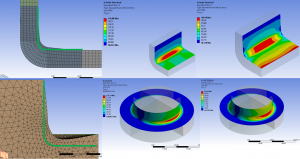The RBF Morph Team took part in the 47th edition of the Italian Conference AIAS 2018 that held in Villa San Giovanni (Italy) 5-8 September, 2018.
Two works about the different applications of RBF Morph technology have been presented:
Automatic shape optimization of structural components with manufacturing constraints
Among optimization procedures, mesh morphing gained a relevant position: it proved to be a suitable tool in obtaining weight and stress concentration reduction, without the need to iterate the numerical model generation. Shape modification through mesh morphing can be performed in an automatic fashion adopting two approaches: defining parameters which will describe the modified shape or exploiting results coming from numerical analyses. With this second approach, it is possible to achieve a very high automation grade: stress values retrieved on component surfaces can be successfully employed to drive the shape modification of the component itself. This ‘driven-by-numerical-results’ automatic approach can lead to complex optimized shapes, which can be easily achieved with modern additive manufacturing processes, but not adopting traditional manufacturing processes. In the present work a method to include manufacturing constraints in a shape optimization workflow is presented and applied to different structural optimization cases, in order to demonstrate how even manufacturing based on traditional processes can take advantage of automatic shape optimization of structural component
Crack propagation analysis of near‐surface defects with Radial Basis Functions mesh morphing
Fracture mechanics analysis is nowadays adopted in several industrial fieldsto assess the capability of components to withstand fatigue loads. Finite ElementMethod (FEM) is a well-established tool for the evaluation of flaw Stress Intensity Factors (SIF) and for the survey of its propagation. Nevertheless the study of the growth of near-surface circular and elliptical cracks is still an arduoustask to be faced with FEM. In fact, the interaction of the flaw with free surfaces leads the crack front to assume complex shapes, whose simulation cannot be easily accomplished. A possible answer to deal with such a problem is to use the mesh morphing technique, a nodal relocation methodology, that allows to cover different problems. In fact, with mesh morphing, it is possible to fit the baseline flaw front with the desired shape (generic shape) and to automatically simulate its evolution at a certain number of cycles. In the proposed work this approach is demonstrated exploiting ANSYS Mechanical as FEM tool and RBF Morph ACT Extension as mesh-morpher.
The presentations can be download in the Presentations and Proceedings 2018.



